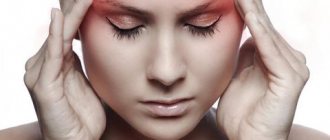Common Causes
What factors affect the forehead and eye area, causing pain:
- vascular diseases of the brain (migraine, venous arthritis, ischemic disease of the vascular network of the brain);
- viral infections;
- influence of bacterial infections;
- consequences of injuries;
- violation of the daily routine;
- severe prolonged stress (the eyes hurt badly, the head hurts in the frontal part after prolonged nervous strain);
- anemia;
- lack of vitamins;
- premenstrual syndrome;
- meningitis;
- tumors;
- hemorrhage.
To understand the true cause of frontal pain, it is necessary to consider the accompanying symptoms. It is by the additional signs and nature of the pain syndrome that we can conclude: the headache in the forehead area is under the influence of the disease, or temporarily affecting external factors.
Cause of pain: disease
How to distinguish neuralgia from frontal sinusitis?
In both cases, the main symptom of the disease is pain in the forehead above the eyes, but nevertheless, it is not difficult to distinguish one disease from another. The pain with neuralgia is stronger, but it is usually short-lived and always one-sided; with frontal sinusitis, the forehead above the eyes constantly hurts on both the right and left sides.
With secondary neuralgia, attacks are not so clearly defined, but the intensity of pain does not depend on changes in head position. If the frontal sinus is inflamed, then when the head is tilted, the exudate inside it moves under the influence of gravity, so when the head is tilted forward, the pain intensifies.
With neuralgia, pain is the only symptom of the disease; frontal sinusitis, in addition, is accompanied by an increase in body temperature, general weakness and nasal congestion.
Frontal sinusitis is treated by an ENT doctor; doing it yourself is not recommended. At the initial stage, antibiotics, anti-inflammatory and antihistamines, vasoconstrictor nasal drops and agents for liquefying sinus secretions are prescribed. If conservative treatment is ineffective, the drainage of exudate from the sinuses is ensured surgically.
Why pain occurs above the eye in the eyebrow area: causes, diagnosis, therapy, prevention
The main factors that can cause pain above the eye in the eyebrow area include neurological disorders. What should you do if pain and discomfort periodically appear above the eye, if the unpleasant sensation radiates to the temple or forehead area, and which doctor should you contact?
Causes of pain above the eye
Few people pay attention to pain in the eyebrow area, attributing it to a temporary phenomenon that will go away on its own. However, such pain can signal the presence of various diseases, both a common cold and serious malignant processes.
Soreness in the eye area is caused by the structure of the human skull; it is in this area that there is a large accumulation of various ducts and sinuses. Depending on the specific location of the pain, you can talk about possible factors that provoked the discomfort. Pathologies can be either neurological or infectious.
Infectious pathologies can theoretically be divided into 2 parts - neurological, that is, diseases of the central nervous system, and infectious. Diseases of the first type include encephalitis, meningitis, and the second - sinusitis, profilitis, frontal sinusitis, and so on.
There are situations when pain in the eyebrows and eyes is not pathological. Most often this is observed as a result of alcohol poisoning, smoking, which often provokes vasospasm and hypoxia, due to poor diet, long and regular work at the computer, and as a result of mental stress.
Symptoms of pathologies that cause pain near the eyebrows
Pain under or near the eyebrow can be a sign of various pathologies within the body. Sometimes this kind of pain can signal the presence of serious pathologies. In this case, in addition to pain around the eyes and eyebrows, concomitant symptoms may also be observed. Most often this includes:
- swelling of the mucous membranes;
- fear of light;
- swelling of the eyelids;
- the appearance of tinnitus;
- severe dizziness, which may occur along with vomiting;
- insomnia;
- constant feeling of fatigue;
- uncontrollable condition.
When the eyebrow above the eye hurts, it is necessary to recognize the strength and frequency, its localization. This will help make the correct diagnosis.
The nature of the pain can vary:
- Cluster pain is an attacking attack, the syndromes of which can be repeated at intervals of 10-20 minutes, while the pain can last up to 3-4 hours.
- Cluster pain is most often activated at night, can last until the morning, and can sometimes migrate to the area of the dental nerves.
- Pain from tension is more common among the fair sex and in older people, has a girdling nature, and may be accompanied by a feeling of general weakness and lack of appetite.
- Migraine is a very severe pain that is usually observed in the temple area.
- Pathological pain - discomfort occurs along with nausea, fear of light, sudden sounds, and other similar symptoms.
There are also secondary pains. The main causes of such pain include hormonal imbalance, trigeminal neuralgia, intracranial pressure, the appearance of neoplasms, traumatic brain injuries and the consequences of surgical interventions.
For example, attacks of severe pain can occur during puberty, menopause, PMS, and also during pregnancy. This is due to the fact that as a result of the influence of female sex hormones on the elasticity of blood vessels, unpleasant sensations develop.
If we are talking about intracranial pressure, then along with pain, a symptom such as bifurcation of objects may appear. Dark circles may appear before the eyes.
Typically, in this condition, microcirculation of the cerebrospinal fluid occurs and its excessive formation occurs. In this case, with ICP, general weakness and drowsiness may occur.
The appearance of neoplasms or injuries can lead to increased intracranial pressure.
If you detect at least a couple of symptoms, seek the advice of a specialist and conduct a thorough examination.
“Why it hurts above the eye - causes and methods of treatment”
- a program that addresses the problem of discomfort in the eye area, its possible causes and methods of treatment.
Diagnosis of pain around the eyes
If you have a headache above the eyebrow, around the eye or under them, you should consult a doctor. To begin with, it is recommended to visit a therapist. After studying your medical history, if necessary, he will refer you to a more specialized specialist. Most often, this requires visiting an otolaryngologist, neurologist, ophthalmologist or trauma surgeon.
In addition to a general examination of the patient, it is necessary to undergo a number of laboratory tests, which include a blood test,, if necessary, an X-ray examination of the facial area of the skull, and other diagnostic measures.
If the first reason is related to pathology in the field of otolaryngology, then it may be necessary to undergo a bacterial culture, which is usually taken from the mucous membranes of the nose.
If vision pathology develops, it is necessary to visit an ophthalmologist, who will carefully examine the fundus of the eye and refer you for more detailed diagnostic studies.
If the problem lies in neurology, then an electroencephalogram or even a computed tomography may be prescribed.
After carrying out diagnostic procedures and making an accurate diagnosis, treatment will be prescribed, which primarily depends on the pathology itself that caused pain above the eye in the eyebrow area.
Why do my eyebrows and between my eyebrows hurt?
Pain in the area between the eyebrows is often observed during migraine attacks, nervous exhaustion, fatigue, and also with intracranial hypertension. As in the case of pain above the right eye, the area between the eyebrows and the eyebrows themselves can hurt as a result of the development of sinusitis or frontal sinusitis.
Even a common cold or runny nose, especially complications, can provoke this kind of discomfort.
In this case, usually, in addition to pain, there may be secretion of mucus or purulent secretion, the appearance of a bursting headache, lacrimation, and hyperthermia.
If frontal sinusitis occurs, then the frontal sinus is affected, in which the patient feels discomfort in the bridge of the nose, severe headaches and nasal congestion. The most common pathologies that can cause pain in the eyebrow area and between the eyebrows include:
- traumatic brain injuries, eyebrow bruises;
- pinched nerves;
- encephalitis;
- meningitis;
- concussion;
- the presence of infectious pathologies in the body, activation of infectious processes.
Based on the above, it is worth noting that pain above the eye is a sign of a wide variety of pathologies. Therefore, it is impossible to make an accurate diagnosis on your own. This should be done by a doctor only after undergoing a thorough examination. For a more accurate diagnosis, it is necessary to describe in detail the location, nature of the pain, and accompanying symptoms.
"Headache in the eyes and forehead"
Informational video that will help you understand the causes of discomfort that occurs in the forehead and eyes.
Source: https://wkrasote.ru/zdorovie/lechenie/bol-nad-glazom-v-oblasti-brovi.html
Causes and symptoms of headaches in the forehead and eyes
In 90% of cases, a situation where there is pressure on the forehead and eyes indicates overwork. The symptom is mild or moderate in severity. It is accompanied by irritability, problems with concentration, pain in the eyes, decreased visual acuity and lacrimation.
Bright lights, loud noises, or intense thought processes enhance the clinical picture. Rest and adjustments to your work schedule will permanently relieve the unpleasant condition. In other cases, the cause of pain turns out to be pathology. Ignoring it threatens to aggravate the problem and develop serious complications.
Migraine
Possible causes of pain in the right eye and head
For effective treatment, it is necessary to determine the cause of the headache and right eye pain. The most common and least dangerous are fatigue, abnormal physical activity, mental or emotional stress. These conditions provoke an increase in blood pressure and vascular spasm, which are relieved by proper rest and taking antispasmodic drugs. However, if your head and right eye regularly hurt, this may indicate a number of chronic diseases - treatment for each of them is prescribed individually.
Migraine
A headache attack that occurs without a specific cause is called a migraine. It is often unilateral, spreading to the left or right side of the head, neck and eyes. It can last from several hours to several days, and in many patients it develops in several stages. Before an attack, an aura is felt - characteristic signs by which one can determine the imminent onset of pain, but it may be absent. Additional symptoms that indicate a migraine include:
- nausea and dizziness;
- digestive disorders;
- pain in the eyes, increased intraocular pressure;
- visual disturbances, the appearance of dots or circles before the eyes.
A separate type of disease is ocular migraine. Its main symptoms are associated with deterioration of visual acuity, blurred vision, pain in and behind the eyes. Treatment consists of taking special anti-migraine medications.
Cluster pain in the right eye and head
Cluster pain is highly intense, but is rare. They appear at certain periods and may be associated with changing weather conditions in spring or autumn. The patient has pain on the right side of the head and right eye, the sensation may spread to the temples of the neck. The pain is often unilateral, but can also be symmetrical. It is accompanied by additional signs:
- impaired and deteriorating vision;
- nasal congestion;
- the appearance of shadows or dots in the field of view;
- lacrimation, especially in bright light;
- drooping of the upper eyelid.
The exact cause of cluster pain is unknown. An acute attack lasts no more than 10 minutes, then the pain decreases, but persists for up to 3 hours. Symptoms often appear daily, at certain times of day.
Trochleitis
Inflammation of the oblique muscle of the eye is trochleitis.
With this disease, the patient has a headache, and painful sensations also appear in the right eye (in the inner corner or above the eyeball). Trochleitis does not develop independently; more often it is a characteristic symptom of a number of autoimmune diseases. It manifests itself in patients with lupus erythematosus, rheumatoid arthritis, Behcet's disease, lymphoma and other dangerous chronic pathologies. The pain is prolonged, can provoke migraine attacks, its intensity can vary from mild to very severe. Treatment is aimed at the underlying diseases, the main goal being to stabilize the patient's condition.
Glaucoma
Another disease that causes headaches and pain in the right eye is glaucoma, or increased intraocular pressure. It may be of hereditary origin; patients with diabetes mellitus, chronic hypertension, myopia and chronic pathologies of the cardiovascular system are also at risk. The disease may not show any symptoms in the first stages, but is then accompanied by the following changes:
- headache, its source is in the right or left eye;
- deterioration of peripheral vision;
- the appearance of circles, spots or other elements before the eyes;
- watery eyes, especially when trying to look at a bright light.
There are two main forms of glaucoma. Open-angle is associated with myopia and in the initial stages occurs without a pronounced clinical picture, then it is dangerous due to chronic pain and loss of peripheral vision. Closed-angle glaucoma develops with farsightedness. Without timely treatment, it can lead to damage to the optic nerve and blindness.
Occipital neuralgia
Headache on the right, eye and neck - these are the main symptoms of occipital neuralgia. It develops with mechanical damage, inflammation or destruction of the occipital nerve. The pain is sharp, throbbing, reminiscent of electrical discharges. The attacks begin and pass abruptly and can begin with careless head movements or prolonged stay in an uncomfortable position. They may also be accompanied by pain in the eyes, nausea, and decreased sensitivity of the skin in the neck and head. Treatment consists of eliminating the cause of neuralgia and taking painkillers.
Inflammation of the optic nerve
Optic neuritis
is an inflammation of the optic nerve that can lead to complete loss of vision.
The process is accompanied by its outer layer - the myelin sheath, as a result of which it cannot transmit nerve impulses. Signals do not reach the brain, so information cannot be processed correctly. Pain in the right side of the head and eye may indicate the first stage of nerve damage. Neuritis also causes characteristic symptoms:
- pain in the right side of the head and eyes, which intensifies when the angle of vision changes;
- impaired perception of the color spectrum;
- blurred vision.
Diagnosis and treatment
If a headache occurs rarely, once every six months, a person does not pay attention to it, because the cause of rare pain is most often overwork. But you should consult a doctor if the pain in your forehead occurs every day, slight discomfort appears, and then the pain intensifies. What specialists can help?
- Local therapist.
- Neuropathologist.
- Ophthalmologist.
- Otolaryngologist.
The doctor examines the patient and interviews him. Try to describe in as much detail as possible the nature of the pain and the features of its occurrence. This will help make an accurate diagnosis. Additional examination methods:
- X-ray of the nose, head.
- MRI (magnetic resonance imaging) of the brain.
- Ultrasound of the brain, vessels of the neck, nose.
- Videoendoscopy of the nasopharynx.
- Sinus probing
- General tests (blood, urine).
Only after diagnosis can treatment begin.
The decision to prescribe appropriate treatment for a disease, the symptom of which is pain in the forehead, should be made by a specialized specialist. At home, an attack can be relieved on your own only in cases where the pain does not accompany a pronounced inflammatory process, and its nature is not distinguished by duration and high intensity.
Which doctor should I contact?
- Therapist;
- Neurologist;
- Otolaryngologist;
- Ophthalmologist;
- Neurosurgeon;
- Oncologist.
Diagnostic methods
These specialists, depending on the expected diagnosis, can prescribe the following types of diagnostics if you have a headache in the forehead area:
- X-ray to exclude ENT diseases.
- Encephalography, Dopplerography or angiography to assess the condition of cerebral vessels.
- CT or MRI to examine the tissues of the brain structures, cervical and spinal regions.
- Clinical tests of blood and urine for the presence of acute infections and inflammatory processes.
- Blood biochemistry for the presence of cancer.
Medications for pain relief
The following drugs can be used as medications to help reduce pain:
- Analgesics (Analgin, Solpadein, Tempalgin, Paracetamol, Aspirin);
- Anti-inflammatory non-steroidal drugs (Ibuprofen, Ketonal, Piroxicam);
- Antispasmodic drugs (Papaverine, Nosh-Pa, Spazgan, Citramon);
- Diuretics (Triampur, Furosemide);
The selection of a specific drug should be made by the attending physician, taking into account the general condition of the body, possible side effects of the drug and contraindications.
Safe folk remedies
It is advisable to try to relieve an attack of pain with folk remedies, from a range of which you can individually choose safe and effective compresses, herbal teas, inhalations and lotions.
Diagnostics
If pain of unknown etiology occurs, you should consult a therapist. The doctor will conduct a survey and initial examination of the patient. Depending on the results of such an examination, he refers the patient to the appropriate specialist.
In some cases, additional diagnostic methods may be required:
- general or biochemical blood test;
- brain tomography;
- cardiogram of the heart.
Such research methods help to most accurately establish the clinical picture.
Often the factor that provokes the appearance of pain in the frontal area is a foreign object entering the eye. In this case, it is enough to simply eliminate it, but doing it yourself is not recommended, since you can damage the retina.
Diagnosis of eye pathologies
Depending on the presence of any additional headache symptoms, the therapist may refer the patient to the following specialists:
- An otolaryngologist is a specialist who examines all ENT organs, most often using x-rays. If the picture shows areas of darkening, this indicates the development of an inflammatory process, accompanied by the formation of pus.
- A dermatologist is a doctor who examines the condition of the skin. To do this, a smear is taken under the skin and under the eyelid.
- Neurologist - most often this specialist deals with the treatment of headaches. Usually, to make a diagnosis, it is enough for a doctor to examine the patient and study the complaints.
In some cases, treatment may be carried out by cardiologists, infectious disease specialists, and allergists. Conclusions about the method of therapy are made after all the necessary diagnostic measures have been carried out.
Features of treatment
If the patient has pain above the eye, the doctor may prescribe pills, special procedures, or even the use of traditional methods of treatment.
Drug therapy
If the cause of the pain syndrome is inflammatory diseases of the sinuses, then treatment is performed under the supervision of an otolaryngologist.
- Painkillers are prescribed: analgesics, non-steroidal anti-inflammatory drugs (Ibufen, Diclofenac).
- To improve the outflow of mucus from the sinuses, thinning drops (Rinofluimucil) are prescribed.
- In case of acute sinusitis, frontal sinusitis, it is necessary to take antibiotics (Sumalek, Amoxicillin, Farmentin).
- Medicines that dilute sputum are taken (Ambroxol, Fluditec).
- Antibacterial drops are prescribed locally (Isofra, Framycesin).
- If there is significant swelling of the nasal mucosa, vasoconstrictor drops (Xylin, Nazivin, Oxymethazaline) are prescribed.
Attention! You cannot start antibiotic treatment on your own at home. The prescription of drugs is made by a doctor, who takes into account the patient’s age and the severity of the disease. The use of antibiotics is possible only after the susceptibility of bacteria to the drug has been determined in a laboratory.
Special procedures
When the eyebrow above the eye hurts, patients with sinusitis and sinusitis are hospitalized. In a hospital setting, special procedures are performed:
- "Cuckoo". Performed for sinusitis. A special bulb is used to rinse the sinuses.
- Rinsing the maxillary sinuses with an antiseptic solution through the nasal passages, through a puncture above the eyebrow.
- In case of frontal sinusitis, a drainage tube is installed in the patient’s forehead to ensure the drainage of pus.
If the patient complains of pain in the eyebrow area, therapeutic measures do not help, surgery is performed.
Folk remedies
Home treatment is used in mild stages of frontal sinusitis, sinusitis, when there is no elevated temperature. Relieve pain and improve the drainage of purulent contents:
- Warming the maxillary sinuses with hot boiled eggs and a bag of salt.
- Inhalation of hot steam from potatoes.
- Inhaling chopped onions.
- Herbal teas: based on chamomile, calendula, geranium, St. John's wort, fireweed.
Remember, if after using home treatment the pain in the eyebrow area does not go away, or you have a fever, you should definitely consult a doctor.
When the causes are identified, treatment must begin. It depends on the disease that caused such symptoms.
For example, a hot shower or a cold compress on the forehead and the aroma of citrus fruits can ease a migraine attack. Medicines are selected only by a doctor after examination and study of research results.
Self-medication without determining the cause will only worsen the situation and cause a number of serious changes in the body.
Modern drugs have a temporary effect, and with prolonged use they become addictive. Therefore, tablets should be used only in a strictly prescribed course without exceeding the dosage. Ibuprofen-based medications are the most effective, as they relieve an attack of headaches with minimal harm to the body. Also among the recommended drugs are analgin and paracetamol.
Drug treatment of headaches
You can relieve pain in the eyebrow area using the simplest remedies recommended by traditional medicine. Of course, they do not cure, but their action can, albeit temporarily, significantly reduce pain.
1 cold compress (apply a piece of cloth to your forehead, first dipping it in cold water or wrapping it in ice);
2 herbal or vegetable-based compress (apply cabbage leaves, burdock leaves or a cotton swab to the painful area, moistening it with potato-beetroot juice).
Remember! Even if, after using tablets and lotions, you feel a significant improvement in your condition and a decrease in pain in the superciliary area, this relief is short-lived. If the pain returns, you should definitely seek help from a medical facility.
If you have pain in your head, you should take a number of measures to help relieve it.
Pain above the eye under the eyebrow
Pain above the eye in the eyebrow area is a symptom of a variety of causes, ranging from colds to tumor processes. Neurological disorders occupy a leading position among the factors causing pain in the brow ridge. If discomfort periodically appears above the eye, which radiates to the temporal and frontal regions, then it is important to consult a neurologist.
If the unpleasant sensation appears for the first time, it is relieved with the help of antispasmodics. In the future, all therapeutic measures are carried out under the supervision of a specialist, otherwise you will seriously harm yourself.
Painful sensations are called primary and appear as a separate pathology, as well as secondary - they arise against the background of another process. The main causes of this type of pain are diseases of the ears, nose, jaw, pinched nerves, high blood pressure, hormonal changes and more.
Nature of pain around the eye
To make a diagnosis, a specialist needs information about the nature of the pain and the exact location of the pain. There are a large number of nerve endings in the forehead area. Neuralgia may begin with pain or the eyebrow begins to twitch.
Depending on the time, strength and frequency, painful sensations are:
- Beams. The attack sometimes lasts about three hours, and each new attack appears every ten to twenty minutes. The cluster nature of pain appears at night and lasts about ten hours. In this case, the patient complains of chills, anxiety, decreased body temperature, and runny nose. Such attacks sometimes last for several months. The true reasons for their appearance are still not fully understood.
- Tension pain. It often occurs in women and older people. Patients talk about the compressive nature of the pain, similar to the feeling of having a tight circle placed on their head. This condition is accompanied by decreased appetite, weakness, nervousness, and decreased concentration.
- Migraine. Throbbing headaches are associated with vascular dysfunction. Stressful situations, weather changes, fatigue - all this can provoke a new attack. As a rule, pain occurs in one part of the head.
When making a diagnosis, the doctor pays attention to the nature of the pain, location and accompanying symptoms. Discomfort above the eye is a sign of a large number of disorders
Secondary pain above the eye
Let's look at the main reasons why the eyebrow above the eye, eyebrow, eyelid and forehead hurts:
What is accommodative asthenopia
- hormonal imbalance. Attacks of severe pain can occur during puberty, menopause, before menstruation, and during pregnancy. Female hormones affect the elasticity of blood vessels, which leads to unpleasant sensations;
- unsuccessful plastic surgery to eliminate wrinkles;
- trigeminal neuralgia. Although neuralgia affects the left eyebrow, the right one can also hurt, since the processes of the trigeminal nerve go to it. Patients complain of excruciating pain that radiates to various parts of the face;
- With intracranial pressure, objects appear in two before the eyes, and dark circles appear before the eyes. The cause of this condition is a violation of the microcirculation of cerebrospinal fluid or its excessive formation. The condition manifests itself in the form of general weakness and drowsiness. Injuries and neoplasms can lead to increased intracranial pressure;
- neoplasm. An accurate diagnosis can indicate the presence of a tumor;
- traumatic brain injuries.
Trigeminal neuralgia is one of the causes of pain above the eye
What diseases cause pain in the brow ridge area?
Unpleasant sensations in the area between the eyebrows can occur due to the following diseases:
- Infectious diseases. Flu, acute respiratory viral infections, and colds can cause pain in the forehead. When the infectious agent is eliminated, the discomfort goes away. This condition is often accompanied by swelling of the eyes, redness, tearing, and pain becomes a secondary concern.
- Intoxication of the body due to a cold or alcohol abuse causes swelling and bulging of the eyeballs.
- Sinusitis. Usually a person’s general condition is disturbed and body temperature rises. Usually, when pressing and tilting the head, the pain intensifies.
It becomes painful above the eyes and with the following eye diseases:
- Barley. The eyelid turns red and increases in size. Internal localization of the process threatens the opening of pus into the eye or even the brain.
- Conjunctivitis. The disease can be of an allergic, viral or bacterial nature. The mucous membrane of the eye becomes red. Patients complain of burning, itching, and pain in the eyes.
- Phlegmon of the orbit. The purulent process can easily spread into the brain tissue, which poses a serious threat to life.
- Inflammation of the eye muscles. Hypothermia, stress, injury, overstrain of the eye muscles - all this can lead to myositis.
Eyebrows hurt due to sinusitis. At the same time, general well-being is often disturbed
Why does it hurt above my right eye?
Poisoning with toxic substances is the most common cause. Dyes, plastic, washing powder, children's toys - these can be a source of toxic substances. In order to avoid this, you should be careful when choosing the items you buy, paying attention to their quality. When choosing food products, be sure to read the ingredients.
Sinusitis, sinusitis, ethmoiditis, colds, encephalitis, meningitis - this is an incomplete list of those diseases that cause pain above the eye on the right.
Separately, I would like to say about osteochondrosis, a disease that has recently become very common. In this case, pinching and compression of the spinal cord roots causes right-sided pain.
The disease is often accompanied by loss of coordination, tinnitus, and dizziness.
As for intracranial pressure, it can either increase or decrease. With hypertension, the pain is bursting or squeezing. The reasons for this condition may be:
- atherosclerosis;
- arterial hypertension;
- kidney diseases;
- VSD;
- osteochondrosis;
- heart defects;
- overwork.
A decrease in intracranial pressure causes painful sensations of a girdling nature. The following reasons can cause such violations:
- stress;
- excessive physical activity;
- hypotension;
- endocrine disorders;
- atherosclerotic changes in cerebral vessels.
Changes in intracranial pressure may cause discomfort above the eyes
Pain in the eyebrow and between the eyebrows
Pain in the area between the eyebrows can occur during a migraine attack, nervous exhaustion, fatigue, or increased intracranial pressure. Separately, I would like to say about frontal sinusitis and sinusitis.
A complication occurs after a cold or runny nose. Sinusitis is characterized by the appearance of a purulent secretion, a bursting headache, lacrimation, and hyperthermia. With frontal sinus, the frontal sinus is affected.
The patient feels pain in the bridge of the nose, unbearable headaches, and nasal congestion.
What to do in this case? Sinusitis is treated by an otolaryngologist. The infectious process is treated with antibacterial therapy.
Let's highlight the diseases that cause eyebrow pain:
- bruise and cut of the eyebrow;
- traumatic brain injury;
- pinched trigeminal or occipital nerve;
- encephalitis;
- meningitis;
- concussion;
- infectious processes.
Often eyebrows hurt when pressed after tattooing and as an allergic reaction to decorative cosmetics. Also, unsuccessfully performed surgery in the eye and eyebrow area can provoke severe pain.
So, pain above the eye is a sign of a variety of diseases, from ophthalmological problems to neurological pathologies, as well as traumatic brain injuries.
A qualified specialist will be able to make an accurate diagnosis after an examination. Pay attention to the nature of the pain, the exact location and accompanying symptoms.
All this information will help in prescribing treatment therapy.
Source: https://gsproekt.ru/simptomy/bol-nad-glazom-pod-brovyu
Receive a package of anti-hypertension medication for FREE
To relieve headaches, various drugs belonging to several groups are used:
- Nonsteroidal anti-inflammatory drugs that produce a weak effect: with acrylacetic acid - Ketorolac, Ketanov, Ketorol, etc.; based on paraaminophenol - Paracetamol, Cefekon, Panadol, Propyphenazone, etc.; anthranils – Etofenamate, Mefenamic acid.
- Nonsteroidal anti-inflammatory drugs that produce a strong effect: with indoleacetic acid - Indomethacin, Sulindac, Etodolac, etc.; based on propionic acid – Naproxen, Ketoprofen, Ibupropheni, etc.; based on phenylacetic acid - Diclofenac, Ortofeni, etc.; based on salicylic acid - Upsarin UPSA, Aspirin, Acecardol, etc.; oxicams - Lornoxicam, Meloxicam, Piroxicam, etc.; coxibs – Rofecoxib, Celecoxib, etc.; pyrazolidines - Butadione, Phenylbutazone, etc.
- Local irritating medications - they effectively warm up the areas where pain occurs, stimulate blood flow, which helps reduce pain. These are local drugs Finalgon, Viprosal, Capsicum, etc.
There are a number of other medications used for headaches associated with different causes. However, the regimen for their use should be prescribed by a specialist, because self-medication can significantly aggravate the situation.










